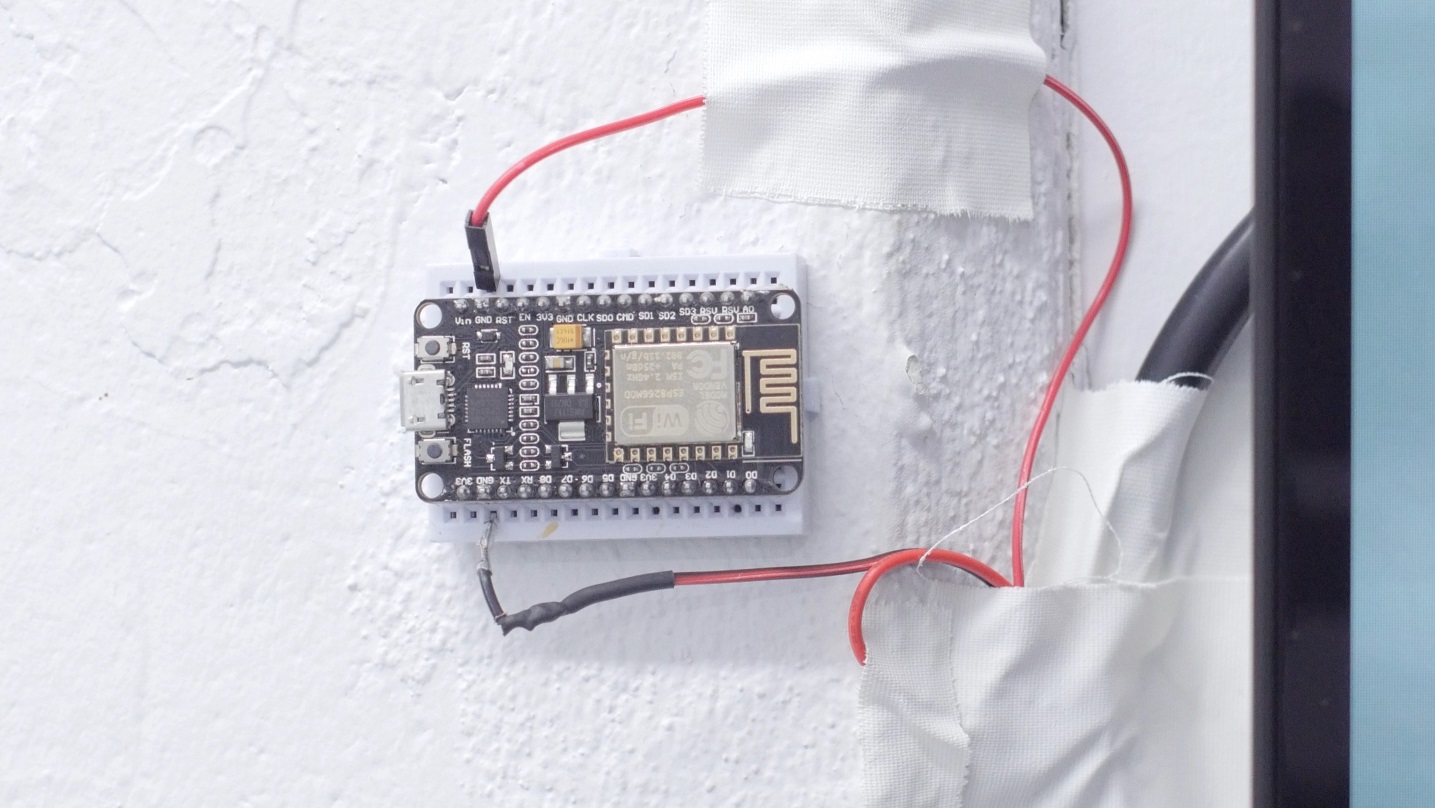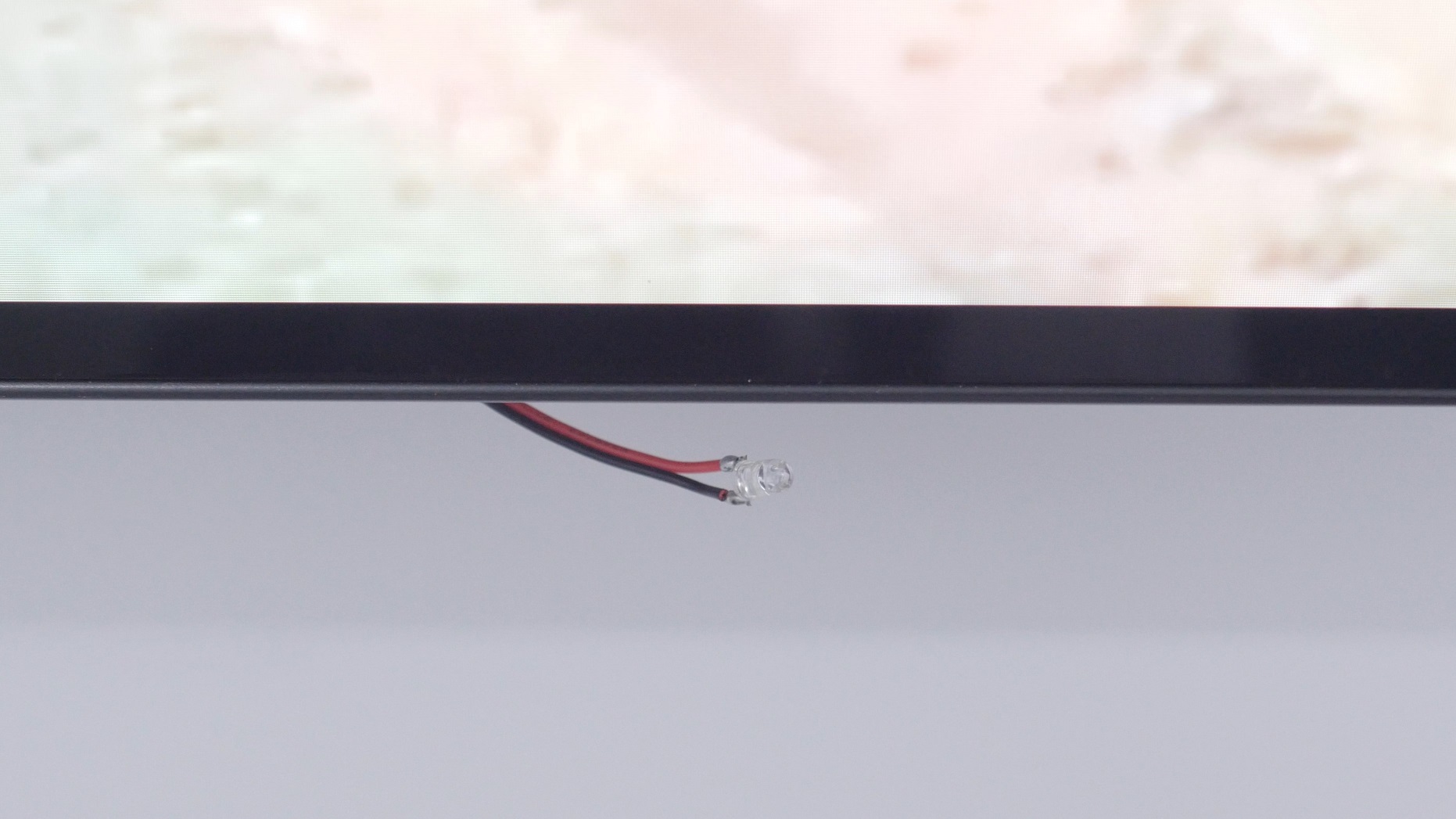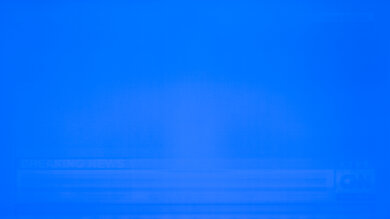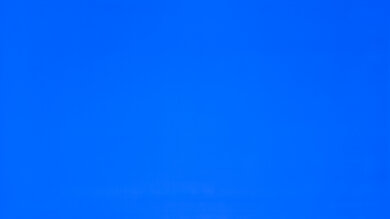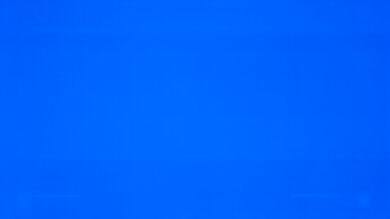OLED TVs have great picture quality; however, there are concerns about their long-term performance due to the possibility of permanent image retention, commonly referred to as burn-in.
Our previous 20 hours per day burn-in test ran for a little over two years, and the OLED TV has permanent image retention. That test was an extreme case, using patterns with a lot of static content.
Based on your feedback and comments, we bought six LG OLED C7s, which played real, non-altered content. It gives a more realistic, real-world example of what to expect depending on how you usually use your TV.
Update 02/22/2023:
We've started a new 100 TV accelerated longevity test, and one goal of that test is to better understand how well modern TVs handle image retention and burn-in. You can learn more about how we designed and built this test in our latest video. Follow along for our updates over the next two years on our new RTINGS com R&D Channel.
Update 11/17/2022:
This test ended in 2019, as we feel that we now have a good understanding of what types of content are likely to cause burn-in. However, we still haven't addressed the issue of longevity in general, and we don't know if newer OLED panels are still as likely to experience burn-in. To that end, we've decided to start a new accelerated longevity test to better understand how long new TVs should last and what are the most common points of failure. Although burn-in isn't the main goal of this test, we're hoping to better understand how newer OLED panels compare to the older generation of OLEDs. It's generally accepted that burn-in isn't as much of an issue as it used to be, but it's unclear just how much better the newer OLED TVs are. With new panels, new heatsinks, and even brand-new panel types like QD-OLED, there are a lot of unknowns.
Final Findings (Updated 05/31/2019 - 9064 Hours)
Update 05/31/2019: The TVs have been running for over 9000 hours (around five years at 5 hours every day). Uniformity issues have developed on the TVs displaying Football and FIFA 18 and are starting to develop on the TV displaying Live NBC. Our stance remains the same: we don't expect most people who watch varied content without static areas to experience burn-in issues with an OLED TV.
Update 11/05/2018: After more than 5000 hours, there has been no appreciable change to the brightness or color gamut of these TVs. Long periods of static content have resulted in some permanent burn-in (see the CNN TVs); however, the other TVs with more varied content don't yet have noticeable uniformity issues on normal content. As a result, we don't expect most people who watch varied content without static areas to experience burn-in issues with an OLED TV. Those who display the same static content over long periods should consider the risk of burn-in, though (like those who watch lots of news, use the TV as a PC monitor, or play the same game with a bright static HUD). Those concerned about the risk of burn-in should go with an LCD TV for peace of mind.
Note that we expect burn-in to depend on a few factors:
-
The total duration of static content. LG has told us that they expect it to be cumulative, so static content, which is present for 30 minutes twice a day, is equivalent to one hour of static content once per day.
-
The brightness of the static content. Our maximum brightness CNN TV has more severe burn-in than our 200 nits brightness CNN TV.
-
The colors of the static areas. We found that in our 20/7 Burn-In Test, the red sub-pixel is the fastest to degrade, followed by blue and then green.
To see how the results at this 5000-hour point compare to your usage, divide 5000 by the number of hours you watch each type of content per day to find the number of days. For example, someone who plays Call of Duty or another video game without bright static areas for two hours per day may expect similar results after about 2500 days of usage. It corresponds to about seven years.
Goal
The goal of the test is to provide an idea of the usage time of a 2017 OLED TV before burn-in becomes apparent, which will depend on your usage. To do so, we replicated five different real-world conditions in an accelerated aging test. We also independently tested two different brightness ('OLED Light') settings with the same content to see the impact.
Test Setup
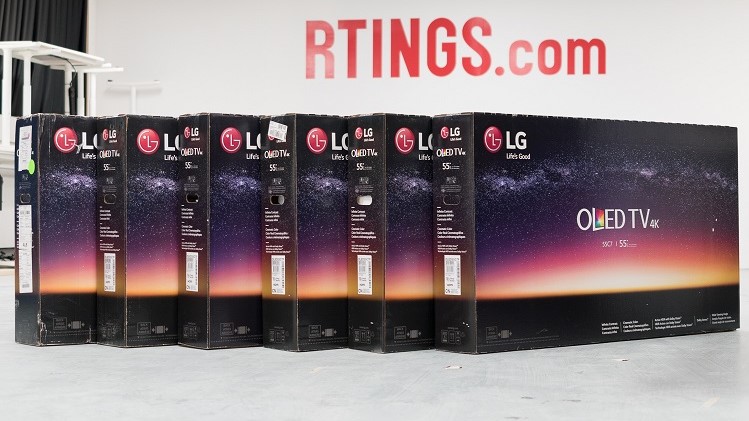
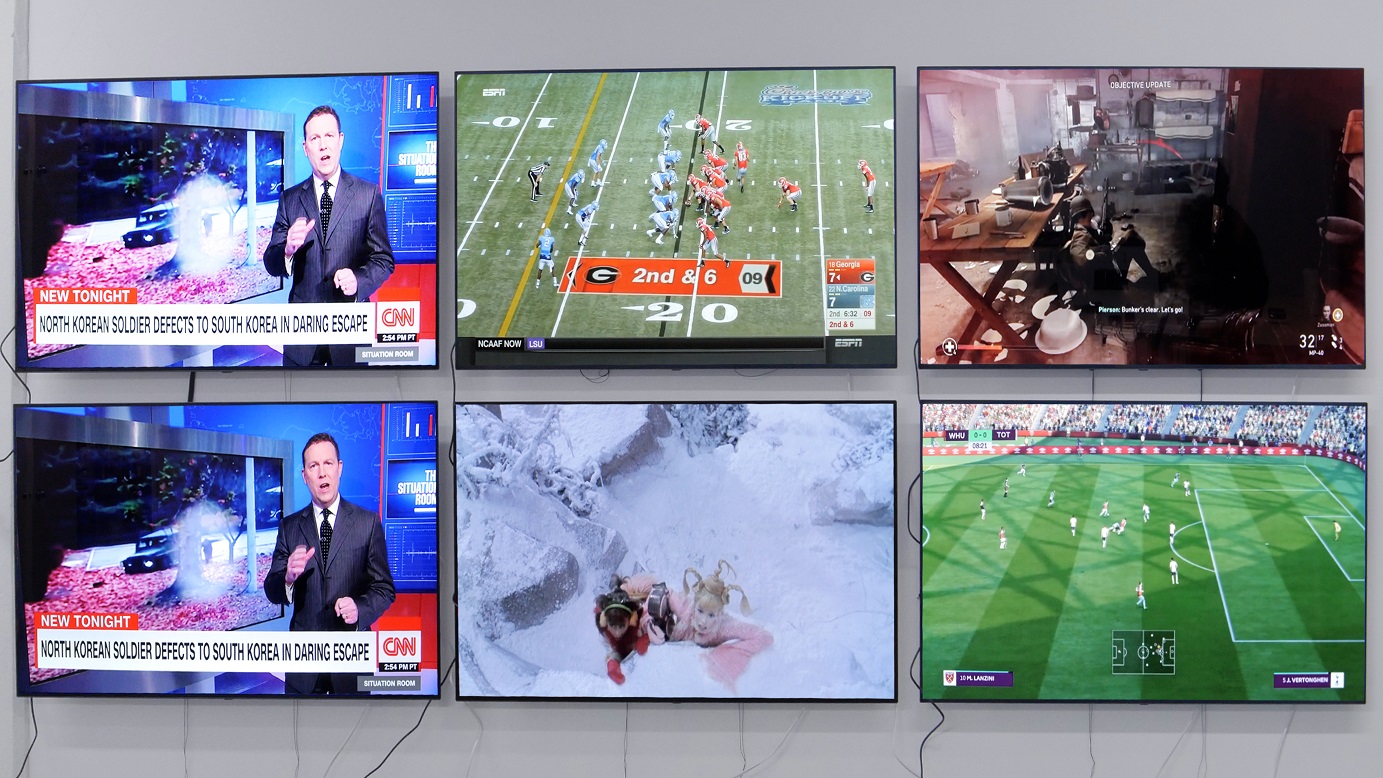
The TVs are all controlled by a microcontroller to repeat a five-hour on and one-hour off-cycle four times per day.
The 'Screen Shift' option was enabled on all TVs, and 'Pixel Refresher' was performed before each set of measurements taken on each TV.
They all played real content (not test patterns) from live cable TV sources, video game clips, or recorded sports. The brightness of all TVs (except the one identified below) was set to 200 nits on a checkerboard pattern, with the content described below.
The settings remained at their default values in the 'isf Dark Room' picture mode, with only the 'OLED Light' adjusted. The specific value depends between units but is typically between 59 and 63 to reach our target of 200 nits. The maximum brightness TV had 'OLED Light' at 100.
The Content
1. Live CNN
CNN was played live on the TV through a cable feed - as a result, this includes all regular broadcast content, including commercials. CNN is a widely watched network news channel, and we have also received concerns regarding this channel specifically. This test is considered a control, with the 'OLED Light' set to a brightness of 200 nits.
2. Live CNN (Maximum Screen Brightness)
As above, live CNN was played on the TV through a cable feed. For this TV, the 'OLED Light' is set to maximum, corresponding to a brightness of 380 nits on our checkerboard pattern. It's to show the relationship between burn-in rate and 'OLED Light' with the same content and over the same period.
3. Football
Many pre-recorded football games were displayed on this TV to represent the usage of someone interested in a particular sport and will watch it regardless of the channel. It includes content from a variety of channels and with different teams, so overlays are located in different areas, and team colors change. It includes many games to avoid too much repetition.
4. Live NBC
This test is informative for people who watch a lot of general TV, since NBC shows a variety of movies, TV shows, sports, and news. The source was a live cable feed and should be representative of a range of general TV content.
5. FIFA 18 gameplay
The goal of the content on this TV is to investigate the effect of a 'high-risk' video game - one which has some bright, static areas which remain very consistent. We have received the most concerns about FIFA 18, so many hours of gameplay footage were used to show typical usage, including many different teams and a mix of menus and gameplay without much repeating.
6. Call of Duty: WWII Gameplay
The gameplay footage on this TV is to represent a relatively 'low-risk' video game. It only has small areas which are static and an overall dim image without too many bright colors. We haven't received any reports of burn-in for this game yet, so consider it a baseline for a low-risk game.
Additional Notes
The Controller
A NodeMCU microcontroller is used to control each TV at all times. It has 6 IR LEDs, which are connected to the IR receiver of each TV, to power them all on and off at specific intervals. The status and toggle times are logged via WiFi to a server to verify accurate timing.
Pixel Refresher
There are a few different 'pixel refresher' functions that run on LG OLED TVs. An 'automatic' pixel refresh runs when the TV is turned off after four hours of cumulative usage. This requires the power to be connected, and LG has told us that this takes between 7 and 10 minutes to complete. As a result, this pixel refresh is automatically run at each power cycle of our test (4 times per day).
There is also a 'manual' pixel refresher function which is toggled through the settings menu. This may take an hour to complete, and we manually run this before taking each set of photos (as described above).
Automatic Backlight Limiter (ABL)
The automatic backlight limiter reduces the brightness of the screen to prevent it from drawing too much power. It occurs when there are large bright areas, and it's why our 100% window measurement of OLED TVs is significantly lower than smaller window sizes (see here). It doesn't mean that increasing the 'OLED Light' will result in a dimmer image. The overall image is still brighter with a higher 'OLED Light' setting.
Results (Last updated 02/10/2020)
Peak brightness & Color Gamut
Uniformity Photos
Every two weeks we will take photos of 50% gray, 100% red, 100% green, 100% blue, 100% cyan, 100% magenta, and 100% yellow patterns and post the photos here. Every two months we will measure the color gamut and HDR peak brightness of each TV.
Limitations
- This test alone only demonstrates the effect of one of the use cases described above. It does not show the effect of changing between multiple sources (such as watching football 20% of the time, playing high-risk video games 50% of the time, and playing low risk video games 30% of the time).
Conclusion
The goal of this test is to provide an idea of an OLED TV's lifespan before burn-in becomes visible when watching real world content. This article will be updated every two weeks with the latest results from our real-world test, and how it should impact your buying decisions depending on your own specific usage.
Changelog
Week 94 (12/18/2019): All measurements and uniformity photos have been updated for all TVs. These results continue to fluctuate between measurements, and there is no obvious trend or change for any TV. The Live CNN (max) TV color gamut is starting to trend downwards, suggesting that the red pixel degradation in the center of the screen is causing the gamut to drop. We'll need more measurements in the future to confirm this hypothesis though.
Week 90 (11/15/2019): The burn-in test was resumed on 10/17/2019. Photos have been retaken today after four more weeks. At week 90, the live NBC TV has started to show a similar shape in the center of the screen to the Max CNN TV at week 36 (Live NBC Week 90 vs Max CNN Week 36). A grid uniformity issue is also starting to appear in the FIFA TV, which may be burn-in from the player selection screen after almost 10,000 hours of game time. Test settings have also been clarified in this article.
Week 72 (07/04/2019): Uniformity, color gamut, and brightness measurements have been updated for all TVs. These results continue to fluctuate between measurements, but there is no obvious trend or change for any TV.
Week 68 (05/31/2019): The uniformity photos have been retaken for all TVs. Next full measurement of uniformity, brightness, and color gamut will be 06/28/2019.
Week 64 (05/06/2019): The peak brightness and color gamut measurements have been updated for all TVs, and the uniformity photos have been taken. The uniformity of the two TVs displaying CNN have continued to degrade, and there is measurement variation from month to month but no trends are noticeable in the peak brightness or gamut measurements of any TVs yet.
Week 60 (04/04/2019): Uniformity photos have been updated. The TVs are now at 8000 hours of runtime.
Week 56 (03/07/2019): All measurements and photos updated. The brightness and color gamuts of all TVs remain in the same ballpark, although there is some variation from measurement to measurement. This variation is too small to be noticeable. Due to the slow rate of change of results, we will be decreasing the rate that photos are taken of the screen to every four weeks, instead of every two weeks. The next uniformity photos will be taken 04/04/2019.
Week 54 (02/21/2019): Photos updated.
Week 52 (02/07/2019): Uniformity photos updated.
Week 50 (01/24/2019): Photos updated.
Week 48 (01/11/2019): All measurements have been updated.
Week 46 (12/13/2018): Photos updated. Some minor uniformity issues are starting to become noticeable on the football TV when displaying uniform color slides. These are located near the bottom center of the screen (the position of many scoreboards). This isn't noticeable in any normal content.
Week 44 (11/29/2018): Uniformity photos updated. The shape in the center of the maximum brightness CNN TV is becoming more noticeable (including in normal content). The TV displaying live NBC also has very slight uniformity issues near the bottom right-hand corner corresponding to the shape of the Today show logo, visible here.
Week 42 (11/15/2018): Uniformity photos updated.
Week 40 (11/05/2018): All photos have been taken and the measurement plots below have been updated. The non-uniform shape near the center of the maximum brightness CNN TV (first noticed in week 36) continues to develop (see here).
Week 38 (10/18/2018): Photos updated.
Week 36 (10/04/2018): Uniformity photos updated. Some faint uniformity issues have appeared in the center of the maximum brightness CNN TV and are visible in red, yellow and magenta slides. We will continue to monitor this over the coming weeks.
Week 34 (09/20/2018): Uniformity photos have been updated.
Week 32 (09/07/2018): All results have been updated. The peak brightness and color gamut of all TVs remain in the same ballpark. The two live CNN TVs continue to burn-in and the FIFA 18 shows some uniformity issues, but these appear to be brighter rather than darker burn-in.
Week 30 (08/23/2018): Photos updated. The color temperature of the 50% gray slide of the TVs is shifting (most notably the 'Live CNN (Max)' and 'Live NBC' TVs are warmer), however, this isn't really noticeable in normal content. The burn-in on the two CNN TVs continues to darken.
Week 28 (08/09/2018): Photos have been updated. CNN burn-in continues to darken.
Week 26 (07/26/2018): Uniformity photos have been updated.
Week 24 (07/23/2018): All results have been updated including peak brightness, color gamut, and uniformity photos. Burn-in is visible on the two TVs displaying live CNN on the red and magenta slide. The peak brightness and color gamut remain almost identical to the last time these measurements were taken in week 16.
Week 22 (06/28/2018): Uniformity photos updated.
Week 20 (06/14/2018): New uniformity photos have been taken. Burn-in on the maximum brightness CNN TV continues to develop as it becomes more visible near the bottom edge of the red photo.
Week 18 (05/31/2018): Uniformity photos have been updated. The maximum brightness CNN TV is showing some darker areas of burn-in on the 'Breaking News' banner.
Week 16 (05/17/2018): All results have been updated including uniformity photos, color gamut measurements, and peak brightness measurements. The brightness of four of the TVs has increased, however, this relatively small difference is unlikely to be noticeable in any content. The two TVs displaying CNN have remained at very similar brightness levels. Color gamut results remain almost identical. Uniformity issues continue to develop on the two TVs displaying live CNN, and this is slightly visible in normal content when looking for it. Next uniformity photos update will be 05/31/2018 and next full update including brightness and gamut is 07/12/2018.
Week 14 (05/04/2018): Uniformity results have been updated.
Week 12 (04/19/2018): New uniformity photos have been taken.
Week 11 (04/10/2018): We contacted LG regarding the strange results in week 4. LG engineers visited our lab a few days ago and were able to confirm the 25% window on the Live CNN and FIFA 18 TVs are a result of a factory issue (see our video here). OLED TVs are produced in a hot process, and after cooling a 25% window is shown on each panel. Some TVs which haven't cooled completely can produce invalid results for the lookup table used by the 'Pixel Refresh' function, causing this 25% window to become visible. Only some 55" OLED TVs were affected during part of 2017.
As this is not an issue with the panel itself, it is possible to apply a fix to the lookup table. LG will apply this fix to anyone who presents this issue to their support, for free, even after the warranty period has long expired. They have fixed our two affected TVs (see the uniformity photos below). Note that this doesn't fix other uniformity issues as the result of static content, only the 25% window caused by a factory defect. LG has also confirmed that there is variation between panels, which is why some OLED appear more prone to developing uniformity issues (as in the case with our Live CNN (200 nits) vs Live CNN (Max).)
Week 10 (04/05/2018): Uniformity photos have been updated. LG engineers visited our lab, and we will post the results of their investigation and an update in the next few days.
Week 8 (03/23/2018): Uniformity, peak brightness and color gamut results updated. Increases in peak brightness across all TVs, but otherwise the measurements remain consistent.
Week 6 (03/08/2018): New: Video: OLED Burn-in Test Update Week 4. Uniformity photos updated. Only minor changes since week 4.
Week 4 (02/22/2018): New uniformity photos have been updated. Uniformity issues are clearly visible on the 200 nits CNN TV in red and magenta slides (but not in normal content). This is unusual, as we would expect the maximum brightness CNN TV to show uniformity issues before the 200 nits CNN TV. The
Week 2 (02/08/2018): Uniformity photos have been taken for all 6 TVs. No issues are visible.
(01/24/2018): The source content has been finalized and the test has been started. Initial measurements and uniformity photos have been posted below.
